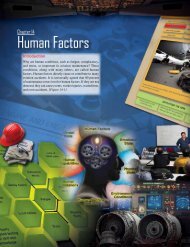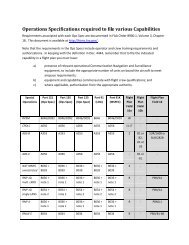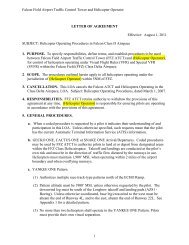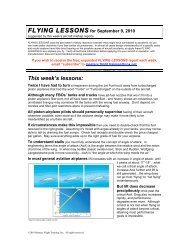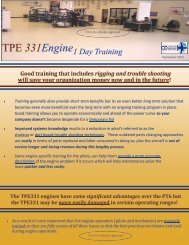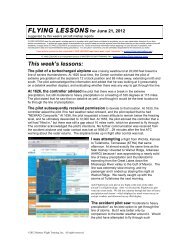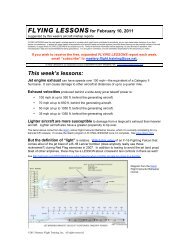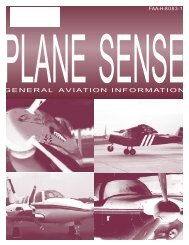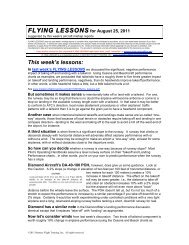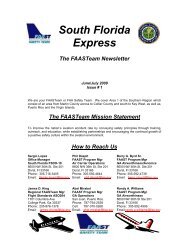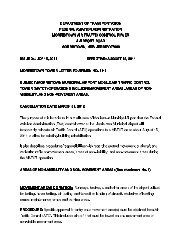Appendix 1, Runway Incursion Avoidance - FAA
Appendix 1, Runway Incursion Avoidance - FAA
Appendix 1, Runway Incursion Avoidance - FAA
- No tags were found...
You also want an ePaper? Increase the reach of your titles
YUMPU automatically turns print PDFs into web optimized ePapers that Google loves.
• Advise the landing traffic that traffic is holding inposition on the same runway.• If advised of a reason for the delay, or the reason isclearly visible, expect an imminent takeoff clearanceonce the reason is no longer an issue.• If a takeoff clearance is not received within 90 secondsafter receiving the “line up and wait” instruction,contact ATC immediately.• When ATC issues intersection “line up and wait”instructions and takeoff clearances, the taxiwaydesignator is included.NOTE: At night or in low visibility, consider lining upslightly left or right of centerline when holding for takeoffso that your aircraft is visible and can be differentiated fromrunway lights.ATC Instructions—“<strong>Runway</strong> Shortened”You should review NOTAMs in your preflight planning todetermine any airport changes that will affect your departureor arrival. When the available runway length has beentemporarily or permanently shortened due to construction,the ATIS includes the words “warning” and “shortened” inthe text of the message. For the duration of the constructionwhen the runway is temporarily shortened, ATC willinclude the word “shortened” in their clearance instructions.Furthermore, the use of the term “full length” will not beused by ATC during this period of the construction. Someexamples of ATC instructions are:• “<strong>Runway</strong> 36 shortened, line up and wait.”• “<strong>Runway</strong> 36 shortened, cleared for takeoff.”• “<strong>Runway</strong> 36 shortened, cleared to land.”When an intersection departure is requested on a temporarilyor permanently shortened runway during the construction,the remaining length of runway is included in the clearance.For example, “<strong>Runway</strong> 36 at Echo, intersection departure,5,600 feet available.” If following the construction, therunway is permanently shortened, ATC will include theword “shortened” until the A/FD is updated to include thepermanent changes to the runway length.Pre-Landing, Landing, and After-LandingWhile en route and after receiving the destination airportATIS/landing information, review the airport diagramand brief yourself as to your exit taxiway. Determine thefollowing:• Are there any runway hold markings in close proximityto the exit taxiway?• Do not cross any hold markings or exit onto anyrunways without ATC clearance.After landing, use the utmost caution where the exit taxiwaysintersect another runway, and do not exit onto another runwaywithout ATC authorization. Do not accept last minuteturnoff instructions from the control tower unless you clearlyunderstand the instructions and are at a speed that ensures youcan safely comply. Finally, after landing and upon exitingthe runway, ensure your aircraft has completely crossed overthe runway hold markings. Once all parts of the aircraft havecrossed the runway holding position markings, you must holdunless further instructions have been issued by ATC. Do notinitiate non-essential communications or actions until theaircraft has stopped and the brakes set.Aircraft LightsThe use of aircraft exterior lights during all flight operationsmake an aircraft operating on the airport surface moreconspicuous and help convey location and intent to you andATC. Some examples of aircraft exterior light usage are listedbelow and shown in Figure 1-16.Turn onEngine(s) runningTaxiingCrossing a runwayEntering departure runway forline up and waitTakeoffStandardized Aircraft LightingRotating beaconNavigation/Position lightsStrobe light*Taxi lightsLogo lightsLanding lights* Strobe lights should not be illuminated if doing so will have anadverse effect on other aircraft or vehicles.Figure 1-16. Standard aircraft lighting.• Engines running—before starting engines, turn on therotating beacon.• Taxiing—prior to commencing taxi, turn onnavigation/position, strobe (only if the use of themdoes not adversely affect other aircraft), taxi, and logolights, if available.1-9





